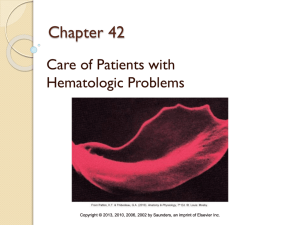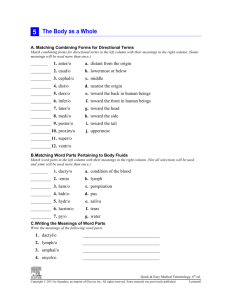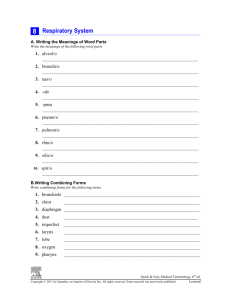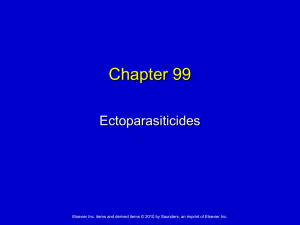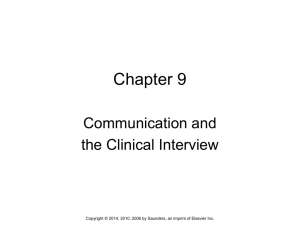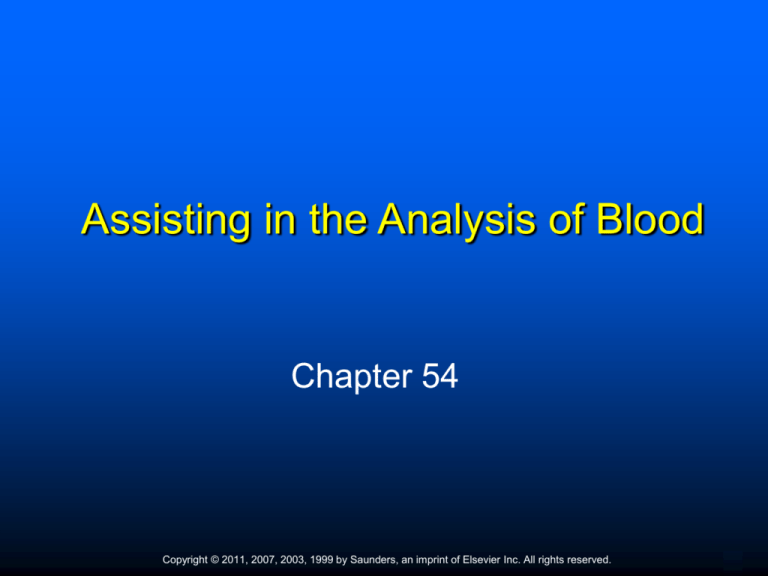
Assisting in the Analysis of Blood
Chapter 54
Copyright © 2011, 2007, 2003, 1999 by Saunders, an imprint of Elsevier Inc. All rights reserved.
1
Learning Objectives
Define, spell, and pronounce the terms listed in
the vocabulary.
Apply critical thinking skills in performing patient
assessment and care.
Name three main functions of blood.
Identify the role of the hematology laboratory in
patient care.
Describe the appearance and function of
erythrocytes.
Define the appearance and function of granular
and agranular leukocytes.
Copyright © 2011, 2007, 2003, 1999 by Saunders, an imprint of Elsevier Inc. All rights reserved.
2
Learning Objectives
Differentiate between T cells and B cells.
Describe the appearance and function of the
thrombocyte.
Explain the process of clot formation.
Identify the anticoagulant of choice for
hematology testing.
Explain the purpose of the microhematocrit
test.
Accurately perform a microhematocrit.
Explain the role of hemoglobin in the body.
Copyright © 2011, 2007, 2003, 1999 by Saunders, an imprint of Elsevier Inc. All rights reserved.
3
Learning Objectives
Perform a hemoglobin test.
Identify the tests included in a complete blood
count (CBC) and their reference ranges.
Explain the principle behind automated blood cell
counting.
Distinguish between normal and abnormal test
results.
Describe the RBC indices and how they are
calculated.
Explain the reasons for performing a WBC
differential.
Discuss the Wright’s stain sequence.
Copyright © 2011, 2007, 2003, 1999 by Saunders, an imprint of Elsevier Inc. All rights reserved.
4
Learning Objectives
Describe the appearance of the normal
erythrocyte.
Describe the appearance of the five different
types of leukocytes seen in a normal
Wright-stained differential.
Cite the reasons for performing an erythrocyte
sedimentation rate test.
Describe the sources of error for the erythrocyte
sedimentation rate test.
Determine an erythrocyte sedimentation rate
using a modified Westergren method.
Copyright © 2011, 2007, 2003, 1999 by Saunders, an imprint of Elsevier Inc. All rights reserved.
5
Learning Objectives
Describe the tests performed to assess
coagulation.
Differentiate between the ABO blood groupings
and the Rh blood groupings.
Secure a capillary blood sample and determine
the ABO and Rh grouping of the sample.
Discuss rare blood types and the implication of
having a rare blood type when transfusion is
necessary.
Describe the methodology behind the clinical
chemistry testing methods used in the physician’s
office laboratory.
Copyright © 2011, 2007, 2003, 1999 by Saunders, an imprint of Elsevier Inc. All rights reserved.
6
Learning Objectives
Explain the reasons for testing blood
glucose, blood cholesterol, hemoglobin A1c,
thyroid hormone levels, and liver enzymes.
Perform a cholesterol test using an
FDA-approved cholesterol monitor.
Summarize typical chemistry panels, the
reason for performing each panel, and the
individual tests performed in those panels.
Copyright © 2011, 2007, 2003, 1999 by Saunders, an imprint of Elsevier Inc. All rights reserved.
7
Hematology
Section of the laboratory that deals with:
Counting RBCs, WBCs, and platelets
Differentiating WBCs on a stained smear
Measuring the percentage of RBCs in blood
Determining the hemoglobin
Copyright © 2011, 2007, 2003, 1999 by Saunders, an imprint of Elsevier Inc. All rights reserved.
8
Complete Blood Cell Count
Red blood cell count
White blood cell count
Hemoglobin determination
Hematocrit determination
Differential white blood cell count
Estimation of platelet numbers
Red cell indices
Copyright © 2011, 2007, 2003, 1999 by Saunders, an imprint of Elsevier Inc. All rights reserved.
9
Critical Thinking Application
Dana will collect the specimen for
Mr. Corrigan’s CBC. What tests are included
in the CBC? Can any of these tests be
performed by capillary puncture? Explain.
Which vacuum tube will Dana use to collect
the CBC?
Copyright © 2011, 2007, 2003, 1999 by Saunders, an imprint of Elsevier Inc. All rights reserved.
10
Whole Blood
Plasma
Clear yellow liquid portion
55% of blood by volume
Formed elements
45% of blood
Erythrocytes (RBCs), leukocytes (WBCs), and
thrombocytes (platelets)
Copyright © 2011, 2007, 2003, 1999 by Saunders, an imprint of Elsevier Inc. All rights reserved.
11
Erythrocytes
Red blood cells (RBCs)
Formed in red bone marrow
120-day life span
Lack nucleus, resulting in biconcave shape
Hemoglobin: transports oxygen
Copyright © 2011, 2007, 2003, 1999 by Saunders, an imprint of Elsevier Inc. All rights reserved.
12
Leukocytes
White blood cells (WBCs)
Contain nucleus
Protect body against infection and disease
Granular or agranular leukocytes
Granular leukocytes – perform phagocytosis
Agranular leukocytes – produce antibodies
Copyright © 2011, 2007, 2003, 1999 by Saunders, an imprint of Elsevier Inc. All rights reserved.
13
Granular Leukocytes
Polymorphonuclear leukocytes
Neutrophils, eosinophils, basophils
Granulated cytoplasm and segmented nuclei
Phagocytic function
Inflammation
Copyright © 2011, 2007, 2003, 1999 by Saunders, an imprint of Elsevier Inc. All rights reserved.
14
Agranular Leukocytes
Lymphocytes and monocytes
Clear cytoplasm and a solid nucleus
Production of antibodies
T cells and B cells
Copyright © 2011, 2007, 2003, 1999 by Saunders, an imprint of Elsevier Inc. All rights reserved.
15
T Cells
Immune response to intracellular parasites, viruses,
fungi, and bacteria.
Cytotoxic or killer T cells—kill foreign, virus-infected,
and tumor cells.
Helper T cells—stimulate the activity of other T cells.
Suppressor T cells—inhibit the activity of other T cells.
Memory T cells—respond quickly to antigens at a later
date.
Natural killer cells—kill cells infected with viruses and
tumor cells without prior sensitization.
Copyright © 2011, 2007, 2003, 1999 by Saunders, an imprint of Elsevier Inc. All rights reserved.
16
B Cells
Formed in bone marrow
Differentiate into plasma cells
Produce specific antibodies against an antigen
• Antibodies are protein molecules that attach to antigens
Complement system – series of reactions between
plasma proteins that amplifies the immunological
response to foreign molecules
• Activation causes lysis of microorganisms or their
phagocytosis by neutrophils
Copyright © 2011, 2007, 2003, 1999 by Saunders, an imprint of Elsevier Inc. All rights reserved.
17
B Cells
Three steps to destroying pathogens
1. Antigen processing – macrophages phagocytize
antigens; break them down into smaller molecules
that are displayed on the macrophage surface
2. Lymphocyte stimulation – T cells stimulate B cells to
start antibody production
3. Antibody production – B cells have repeated cellular
divisions, enlargement, and differentiation to create
an effective number of plasma cells that secrete
specific antibodies that bind to the antigen, making
them easier to ingest by white cells or killing the
bacteria directly
Copyright © 2011, 2007, 2003, 1999 by Saunders, an imprint of Elsevier Inc. All rights reserved.
18
Thrombocytes
Cytoplasmic fragments of megakaryocyte
Smallest formed element
Copyright © 2011, 2007, 2003, 1999 by Saunders, an imprint of Elsevier Inc. All rights reserved.
19
Clot Formation
Initiated by blood platelets.
Combines with calcium to form thromboplastin.
Then converts prothrombin into thrombin.
Thrombin converts fibrinogen to fibrin.
Blood cells and plasma are enmeshed in the
network of minute threadlike structures called
fibrils to form a clot.
Copyright © 2011, 2007, 2003, 1999 by Saunders, an imprint of Elsevier Inc. All rights reserved.
20
Hemophilia
Bleeding disorder
Mutation of clotting factor genes
Hereditary, sex-linked disorder
Treatment:
Injection of purified clotting factor to prevent bleeding
episode
Copyright © 2011, 2007, 2003, 1999 by Saunders, an imprint of Elsevier Inc. All rights reserved.
21
Plasma
Liquid that is the carrier for formed elements
and other substances
Proteins, carbohydrates, fats, hormones, enzymes,
mineral salts, gases, and waste products
90% water, 9% protein, and 1% other
When plasma proteins and other components
are used up during the clotting process, the
remaining liquid is called serum
Copyright © 2011, 2007, 2003, 1999 by Saunders, an imprint of Elsevier Inc. All rights reserved.
22
Collection of Blood Specimens
Capillary puncture can be used for most blood
samples
Venipuncture is used when a larger sample is
required
CBC – venous blood collected in an EDTA tube to
prevent clotting
Copyright © 2011, 2007, 2003, 1999 by Saunders, an imprint of Elsevier Inc. All rights reserved.
23
Hematocrit
Measurement of the percentage of packed
RBCs in a volume of blood
Spun microhematocrit test – cellular elements
separated from plasma by centrifugation
Capillary tubes are placed in a centrifuge
After centrifugation, RBCs will be at the bottom
of the tube, WBCs and platelets in the center,
and plasma on the top.
Percentage read with a microhematocrit reader
Copyright © 2011, 2007, 2003, 1999 by Saunders, an imprint of Elsevier Inc. All rights reserved.
24
Centrifuge with Capillary Tubes
Copyright © 2011, 2007, 2003, 1999 by Saunders, an imprint of Elsevier Inc. All rights reserved.
25
Hematocrit Test Results
Copyright © 2011, 2007, 2003, 1999 by Saunders, an imprint of Elsevier Inc. All rights reserved.
26
Hemoglobin
A rough measure of the oxygen-carrying capacity of
blood
Individual test or part of CBC
Hemoglobinometer – colorimeter that determines
hemoglobin by measuring the amount of light absorbed
by a sample of blood in which the hemoglobin has
been released and chemically modified
HemoCue
Copper sulfate method – used to screen blood donors;
a drop of blood with normal hemoglobin values falls
rapidly to the bottom; if it drop falls slowly or not at all,
the hemoglobin levels are low
Copyright © 2011, 2007, 2003, 1999 by Saunders, an imprint of Elsevier Inc. All rights reserved.
27
Hemoglobin Machine
Hand-held instrument
Courtesy Stanbio Laboratory.
Copyright © 2011, 2007, 2003, 1999 by Saunders, an imprint of Elsevier Inc. All rights reserved.
28
Hemoglobin Determination
Copper sulfate method
From Stepp CA, Woods MA: Laboratory procedures for medical
office personnel, Philadelphia, 1998, Saunders.
Copyright © 2011, 2007, 2003, 1999 by Saunders, an imprint of Elsevier Inc. All rights reserved.
29
Normal Hemoglobin Values
From Stepp CA, Woods MA: Laboratory procedures for medical office personnel, Philadelphia, 1998, Saunders.
Copyright © 2011, 2007, 2003, 1999 by Saunders, an imprint of Elsevier Inc. All rights reserved.
30
Red Blood Cell Count
Approximates the number of circulating RBCs
Anemia: oxygen-carrying capacity of blood is
below normal limits
Elevated during dehydration, polycythemia vera,
or severe burns and in people who live at high
altitudes
Normal RBC values range from four million to
six million cells/mm3
Copyright © 2011, 2007, 2003, 1999 by Saunders, an imprint of Elsevier Inc. All rights reserved.
31
White Blood Cell Count
Approximation of the total number of leukocytes
in blood
Aids in determining whether an infection is
present and in diagnosing leukemia
Used to measure response to treatment
Average adult range is between 4,000 and
11,000 cells/mm3
Elevation of WBCs is called leukocytosis.
Decrease in the WBC count is called leukopenia
Copyright © 2011, 2007, 2003, 1999 by Saunders, an imprint of Elsevier Inc. All rights reserved.
32
Critical Thinking Application
Distinguish between normal and abnormal test
results in the following patients:
Maggie McGuire, age 6 years, has a hematocrit of
38%. Is that normal?
Carlos Santiago, age 54 years, has a WBC count of
13,000/mm3 and Dr. Fischbach asks to see his
previous blood work. Why?
Angelina Washington, age 23 years, has an Hct of
32% and Hbg of 10. Why would she be diagnosed
with anemia?
3
Rose Conrad has a platelet count of 142,000/mm .
Why is Dr. Fischbach concerned about a bleeding
disorder?
Copyright © 2011, 2007, 2003, 1999 by Saunders, an imprint of Elsevier Inc. All rights reserved.
33
Red Cell Indices
Calculations performed using information from
the CBC
Provide information about RBC disorders
Mean corpuscular volume (MCV)
Mean corpuscular hemoglobin (MCH)
Mean corpuscular hemoglobin content (MCHC)
Red cell distribution width (RDW)
Copyright © 2011, 2007, 2003, 1999 by Saunders, an imprint of Elsevier Inc. All rights reserved.
34
Differential Cell Count
Purpose is to analyze and quantitate the types
of WBC
Manually stained blood smear
Automated instrument
Copyright © 2011, 2007, 2003, 1999 by Saunders, an imprint of Elsevier Inc. All rights reserved.
35
Preparation of Blood Smears
for the Differential
Blood smear enables a view of cellular
components of blood
Morphology of leukocytes, erythrocytes, and
platelets
Size, shape, and maturity
Prepared by spreading a drop of blood on a
clean glass slide
Copyright © 2011, 2007, 2003, 1999 by Saunders, an imprint of Elsevier Inc. All rights reserved.
36
Blood Smears
Three kinds of smears
Coverglass smear, spun smear, and wedge smear
Should cover ½ to ¾ of the slide
Copyright © 2011, 2007, 2003, 1999 by Saunders, an imprint of Elsevier Inc. All rights reserved.
37
Blood Smears
Gradual transition from thick to thin end
Smooth appearance, dried, labeled
Cells should be distributed evenly
Copyright © 2011, 2007, 2003, 1999 by Saunders, an imprint of Elsevier Inc. All rights reserved.
38
Stains
Polychromatic stains – contain dyes that will
stain various cell components different colors
Methylene blue, eosin
Wright’s stain
Copyright © 2011, 2007, 2003, 1999 by Saunders, an imprint of Elsevier Inc. All rights reserved.
39
Normal Blood Cells
Observe and evaluate cell size, nuclear appearance,
and cytoplasmic characteristics
Results of observing these three features will allow
for cell identification
Examined using oil-immersion objective
RBCs – most numerous blood cells; biconcave disks
that have no nuclei; appear pinkish tan
Thrombocytes – smallest cellular element; round or
oval without a nucleus; stain blue; normal platelet
count is 150,000 to 400,000/mm3. An increase in
platelets is thrombocytosis and a decrease is
thrombocytopenia
Copyright © 2011, 2007, 2003, 1999 by Saunders, an imprint of Elsevier Inc. All rights reserved.
40
Red Blood Cell Morphology
From Stepp CA, Woods MA: Laboratory procedures for medical office personnel, Philadelphia, 1998, Saunders.
Copyright © 2011, 2007, 2003, 1999 by Saunders, an imprint of Elsevier Inc. All rights reserved.
41
Blood Cells
Leukocytes – largest of blood cells; five types
have a characteristic appearance
Granulocytes – neutrophils, eosinophils, and
basophils; contain distinctive granules in their
cytoplasm and may have segmented nuclei
Agranulocytes – lymphocytes and monocytes;
few, if any, granules and nonsegmented nuclei
Neutrophils – most numerous WBCs in
circulation; perform phagocytosis
immature form of a neutrophil is called a band or stab;
increase seen in infections
Copyright © 2011, 2007, 2003, 1999 by Saunders, an imprint of Elsevier Inc. All rights reserved.
42
Blood Cells
Eosinophils – phagocytic; elevated with allergies
such as hay fever and asthma
Basophils – associated with the immediate immune
response to external antigens
Lymphocytes – second most numerous type of
WBC in adults and most numerous in children;
recognize foreign antigens and produce antibodies;
increased numbers with viruses, bacterial
infections, leukemias
Monocytes – largest WBC; called macrophages
when they enter tissues and ingest bacteria and
debris of cellular breakdown
Copyright © 2011, 2007, 2003, 1999 by Saunders, an imprint of Elsevier Inc. All rights reserved.
43
Differential Examination
Normal values vary with age. Adult reference
ranges:
Neutrophils: 40% to 60%
Lymphocytes: 20% to 40%
Monocytes: 2% to 8%
Eosinophils: 1% to 4%
Basophils: 0.5% to 1%
Band: 0% to 3%
Copyright © 2011, 2007, 2003, 1999 by Saunders, an imprint of Elsevier Inc. All rights reserved.
44
Erythrocyte Sedimentation Rate (ESR)
Measures the rate at which erythrocytes
gradually separate from plasma and settle to
the bottom of a specially calibrated tube in
an hour
General indication of inflammation
Increases are found in chronic infections,
rheumatoid arthritis, tuberculosis, hepatitis,
cancer, multiple myeloma, rheumatic fever,
and lupus
Copyright © 2011, 2007, 2003, 1999 by Saunders, an imprint of Elsevier Inc. All rights reserved.
45
Wintrobe ESR
From Stepp CA, Woods MA: Laboratory procedures for medical office personnel, Philadelphia, 1998, Saunders.
Copyright © 2011, 2007, 2003, 1999 by Saunders, an imprint of Elsevier Inc. All rights reserved.
46
Coagulation Testing
Prothrombin time (PT) is tested with a hand-held
instrument
Method of measuring how well the blood clots
PT used to monitor anticoagulant therapy
Results reported as number of seconds blood takes
to clot when mixed with a thromboplastin reagent
International Normalized Ratio (INR) – standard unit
for reporting PT results rather than the time in
seconds; normal PT values are 10 to 13 seconds or
an INR value of 1 to 1.4; anticoagulant is adjusted
so INR values are 2 to 3
Copyright © 2011, 2007, 2003, 1999 by Saunders, an imprint of Elsevier Inc. All rights reserved.
47
Immunohematology
Formerly called the blood bank
Responsible for blood typing or cross-matching
of blood types
Prevents problems caused by incompatibility of
blood types
Copyright © 2011, 2007, 2003, 1999 by Saunders, an imprint of Elsevier Inc. All rights reserved.
48
Blood Grouping
Two major blood antigen systems: ABO and
Rh; four major blood groups: A, B, O, and AB;
person is either Rh positive or Rh negative
About 85% of U.S. population is Rh positive
Blood type is inherited
Copyright © 2011, 2007, 2003, 1999 by Saunders, an imprint of Elsevier Inc. All rights reserved.
49
Blood Grouping
Copyright © 2011, 2007, 2003, 1999 by Saunders, an imprint of Elsevier Inc. All rights reserved.
50
Blood Compatibility
Type O – no antigens; anti-A and
anti-B antibodies; universal donors
Type A – type A antigen; anti-B antibodies;
O and A donors
Type B – type B antigen; anti-A antibodies;
O and B donors
Type AB – type AB antigen; no plasma
antibodies; universal recipients
Copyright © 2011, 2007, 2003, 1999 by Saunders, an imprint of Elsevier Inc. All rights reserved.
51
Rh Factor
Rh factor – first discovered in rhesus monkeys
Test detects presence of proteins (D antigens) on the
surface of RBCs
Rh+ blood agglutinates in the presence of anti-D
antiserum; Rh– does not agglutinate in the presence of
anti-D antiserum
If an Rh– mother is exposed to the Rh+ blood of her infant
during pregnancy, miscarriage, abortion, or delivery she
develops antibodies against the D antigen that cross the
placenta and destroy the RBCs of the fetus in a
subsequent pregnancy
Rho(D) immune globulin is given to Rh– mothers to
prevent the infant’s Rh+ cells from stimulating the mother’s
immune system
Copyright © 2011, 2007, 2003, 1999 by Saunders, an imprint of Elsevier Inc. All rights reserved.
52
Blood Glucose Testing
Blood glucose tolerance test.
Self-monitoring of blood glucose.
Urine reagent strips
Blood glucose monitors using electrochemisty
The medical assistant can perform glucose
testing.
Blood glucose is routinely monitored for
diabetes.
Copyright © 2011, 2007, 2003, 1999 by Saunders, an imprint of Elsevier Inc. All rights reserved.
53
Glycosylated Hemoglobin
Provides information about the average blood
sugar level during the past 2 or 3 months.
Glucose binds to hemoglobin molecules within
RBCs; amount of glucose that is bound to
hemoglobin is directly tied to the concentration of
glucose in the blood.
Measuring the amount of glucose bound to
hemoglobin can provide an assessment of
average blood sugar control during the 60 to
90 days preceding the test.
Normal HbA1c levels between 4 and 6%; goal for
diabetic patients are levels less than 7%.
Copyright © 2011, 2007, 2003, 1999 by Saunders, an imprint of Elsevier Inc. All rights reserved.
54
Cholesterol Testing
Recommended that adults over the age of 20 years
have a cholesterol test at least once every 5 years
Total cholesterol
HDL – “good” cholesterol; high level protects against
heart attack; carries cholesterol away from arteries
and back to the liver for excretion
LDL – high levels reflect an increased risk of heart
disease; called “bad” cholesterol
Recommendations – total cholesterol levels under
200 mg/dl; over 240 mg/dl indicates high-risk category
for coronary heart disease
Copyright © 2011, 2007, 2003, 1999 by Saunders, an imprint of Elsevier Inc. All rights reserved.
55
Thyroid Hormone Testing
Thyroid produces T3 and T4; affect metabolism,
growth, and development
Pituitary produces TSH – stimulates thyroid to
produce hormones; first test is to measure TSH
levels
Screen patients for hypothyroidism
Copyright © 2011, 2007, 2003, 1999 by Saunders, an imprint of Elsevier Inc. All rights reserved.
56
ALT and AST Testing
Certain drugs can impair liver function; liver
damage releases enzymes that can be tested.
Drugs include statins (lower blood cholesterol),
certain antidiabetic drugs, and
antihypertensives
Monitor liver function during therapy with drugs
that have a potential for causing liver
malfunction
Copyright © 2011, 2007, 2003, 1999 by Saunders, an imprint of Elsevier Inc. All rights reserved.
57
Chemistry Panels
Automated blood chemistry analyzer.
Several analytes may be tested at once.
Renal or liver panel.
Typical panels are shown in Table 54-9.
Copyright © 2011, 2007, 2003, 1999 by Saunders, an imprint of Elsevier Inc. All rights reserved.
58





